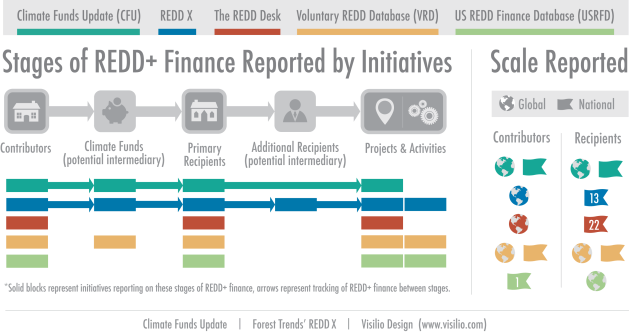Charlene Watson, ODI and Marigold Norman, Forest Trends
Finance for Reducing Emissions from Deforestation and Degradation plus conservation (REDD+) activities has been flowing for at least five years now. But what can we really say about how much finance there has been, where it has come from, where it is going, and what it is being spent on? Climate Funds Update and Forest Trends’ REDDX has been promoting cross-pollination among various REDD+ finance initiatives in an attempt to answer these questions. This is the first in a series of blogs where several initiatives reporting on REDD+ finance will contribute.
As we can dramatically slow climate change by saving tropical forests, developed countries have pledged billions to pilot REDD+ and create accounting mechanisms that will support preparation for REDD+ in the longer term. No one, however, really knows how much of that money has actually been deployed – let alone where and how. With more information on REDD+ finance, a better understanding of REDD+ finance flows can help national governments assess existing gaps and direct REDD+ investments to the most efficient mechanisms and activities with the greatest returns.
While several efforts are underway to try to track REDD+ finance, no two efforts seem to come up with the same numbers. The REDD+ Partnership’s Voluntary REDD+ Database, for example, reports a global total of US$6.27 billion in contributions between 2006 and 2022, while the Climate Funds Update, a project of the Overseas Development Institute, reports US$4.2 billion pledged through dedicated climate funds and initiatives since 2008.
Why the Discrepancy?
Following billions across the globe is no easy task; we know this from efforts to track climate finance more broadly. Tracking requires sustained and on-going efforts to source, validate, and present information in a comparable way. The Climate Knowledge Brokers Group is an exemplary initiative working towards this end. Current discrepancies in REDD+ finance numbers reflect different scale, data sources, and focus of the stage and type of finance, different definitions to count ‘REDD+’ activities, and different terminology for whether the money has been spent or not.
For example as can be seen from the Scale Reported diagram, the Climate Funds Update tracks finance at both the global and national levels, identifying a total global figure of US$1.5 billion in ‘approvals’ in REDD+ finance. This flows through dedicated climate funds and initiatives such as the Amazon Fund, Congo Basin Forest Fund, Forest Carbon Partnership Facility and UN-REDD Programme. REDDX on the other hand, does not specifically track global levels of REDD+ finance, instead focusing on public and private ‘commitments’ and ‘disbursements’ at the national level, to present in-depth information on how finance flows from global contributors to the ground in thirteen countries across Latin America, Africa, and Asia Pacific (with national data currently reported for Brazil, Ecuador, Ghana, and Vietnam).
Given that no initiative claims to be comprehensive, the existing REDD+ finance tracking initiatives can and should play complementary roles. They will only succeed by working together and building up a more comprehensive picture of REDD+ finance.
Clarifying complexity
The first achievement of working together will be in clarifying the complexity by working out each initiatives niche within REDD+ finance tracking. The main stages of REDD+ finance reported diagram illustrates how different initiatives retain different focus. Climate Funds Update and REDDX, for example, track flows of finance and report information on contributors, climate funds, recipients, and in-country REDD+ projects and/or activities. Whereas, the REDD Desk has focussed on in-depth analysis and information on the main REDD+ contributors, recipients, and projects/activities highlighting significant political, legal, and historical context for REDD+ in twenty-two countries. The REDD+ Partnership’s Voluntary REDD+ Database is different again, providing information voluntarily reported by contributors, climate funds, and primary recipients including some information on intended REDD+ projects and activities. And the US REDD Finance Database details information on US contributions to all projects and activities that are related to REDD+.
This blog series will highlight some of the persistent challenges in tracking REDD+ finance and the ways that initiatives are working to overcome these responding to some of questions posed at the outset. Many of these challenges apply to cross-cutting efforts to monitor and account for climate finance. But there is a clear need to build up a more comprehensive and up-to-date picture of REDD+ finance in particular because the large number of voluntary initiatives monitoring REDD+ presents an opportunity to consolidate information and create a more complete picture of what is happening on REDD+ finance, demonstrating how initiatives can collaboratively work together, and initiating a discussion around broader gaps and needs. Over the coming weeks we will ask:
- Who counts what as REDD+ finance? We will offer recommendations for tracking initiatives to harmonise their approaches so that data is comparable.
- Who’s open about REDD+ finance? We will examine efforts to bring more transparency to REDD+ finance, both nationally and internationally.
- What do we know about private sector REDD+ finance? We will consider options to improve our understanding of the role of private actors.
Part of the responsibility to build a more comprehensive picture of REDD+ finance rests with the growing number of initiatives tracking it. Through individually investing in their niche REDD+ tracking areas, while at the same time working together to assess collaborative results, initiatives such as REDDX and Climate Funds Update can reduce confusion to reveal a more accurate and comprehensive picture of the global state of REDD+ finance.
This series of blogs on REDD+ finance intends to create a forum for debate and exchange of ideas through inviting external authors to post their opinions. It should not be understood to reflect the views of ODI or Climate Funds Update.

